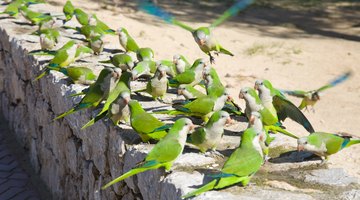How to Attract Wild Quaker Parrots to a Yard
Supplying their favorite foods in a safe setting may attract showy Quaker parrots to your yard. These large birds, also known as monk parakeets, were introduced to the United States from South America as pets. Escapees and released birds became established as flocks and breed in the wild, often in urban settings.

As entrancing as Quaker parrots may be to watch, they are an invasive species known as a crop pest in their native South American range. Before you attract them to your yard, consider whether or not they will be safe from neighbors who might not appreciate them as much as you do.
Know What They Need
Quaker parrots eat fruit, nuts, seeds, grain, leaf buds, insects and blossoms. They also eat garden vegetables. Trees, shrubs and vines that produce berries and other fruit can attract them to your yard. Quaker parrots use sticks to create elaborate nests. If you provide lots of twigs, your yard might become a host to their nests. Some nests resemble condominiums with chambers for multiple families. A power company employee quoted in Fort Lauderdale, Florida's "Sun Sentinel" stated the nests can be as big as a car. Some power companies blame the nests for expensive damage to power lines and for power outages.
Prepare for Them
Although wild parrots don't mimic human speech, their natural calls are loud. The squawking and other vocalizations go on at length. When choosing a feeding site for Quaker parrots, consider their potential predators, including domestic and feral cats and hawks. Ideally, the feeding site should be a large flat platform at least 8 feet above ground. Although Quaker parrots will eat on the ground, a raised platform will keep them safer from predators and can be positioned in your garden so that you can view the birds from indoors as well as outdoors.
Be Consistently Hospitable
Favorite foods for your hoped-for guests include safflower seeds and pears. They also feed on bird seed in bird feeders. Bird feeders are important food sites for the wild parrots, especially in winter. Put out clean water, too. Keep the food supply abundant and consistent. Consistent feeding is crucial to keep the parrots coming back and to encourage them to nest nearby. Be prepared for increased numbers of birds. Quaker parrots fly in groups that may number up to 50 birds.
Understand the Controversies
In some areas, wild Quaker parrots are so popular that social media sites celebrate them and websites offer information on where they are sighted. In some states, governments strive to eradicate them because they can damage crops and electrical lines. Reduce the risk of conflicts for your household and the birds; before attempting to attract Quaker parrots, check with your state's Fish and Wildlife Department about whether or not the birds are considered pests in your area. Wild parrots aren't pets. Domesticated parrots are hand-fed as babies and become accustomed to people. Wild birds travel in flocks and need their freedom to be healthy and content. A wild bird may suffer injury, psychological trauma and poor health from capture and confinement. In many states, it is illegal to own a Quaker parrot, including a domesticated one.
References
Resources
Writer Bio
Gryphon Adams began publishing in 1985. He contributed to the "San Francisco Chronicle" and "Dark Voices." Adams writes about a variety of topics, including teaching, floral design, landscaping and home furnishings. Adams is a certified health educator and a massage practitioner. He received his Master of Fine Arts at San Francisco State University.
Photo Credits
- Tamara Kulikova/iStock/Getty Images
- Tamara Kulikova/iStock/Getty Images
More Articles



